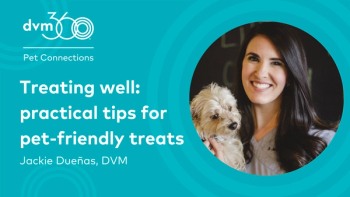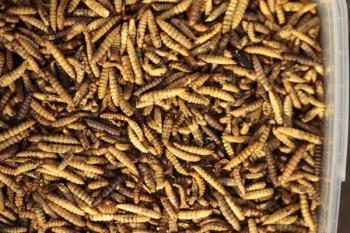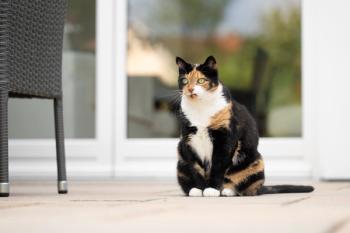
- Vetted January 2020
- Volume 115
- Issue 1
Building a strong recommendation for a veterinary therapeutic diet
When it comes to nutritionally sensitive conditions such as kidney disease, make sure your client understands just how vital a role diet plays in managing their pets health.
When recommending a therapeutic diet, make sure that the client understands why the diet is important and how crucial it is to the health of their pet. (shutterstock.com)Recommending a therapeutic diet can be tricky. Clients might understand what you're saying but then go to the pet store and buy a food that “supports kidney health,” thinking it's the same thing as what you recommended. In a session at
While you've likely faced some resistance to your recommendations in practice before, you might not be aware of the scope. Dr. Heinze cited a client compliance study conducted by AAHA in 2009 that found that only about 21% of clients were compliant with therapeutic diet recommendations.1 Granted, the study is old, but current pet food marketing trends and increased pet owner focus on what they're feeding may have made compliance worse, not better.
The reasons clients are noncompliant can vary from resistance to the cost of the diet, to not understanding why the diet is important, to having some problem with ingredients in the diet or distrusting the manufacturers who produce it.
Dr. Heinze-who is chief academic officer of the Mark Morris Institute, an adjunct faculty member at the Cummings School of Veterinary Medicine at Tufts University, and one of the founders of the
Compliance and kidney disease
Especially in the case of cats with chronic kidney disease, recommendations need to be strong and clear, as diet in these cases is incredibly important, Dr. Heinze says. In a study conducted in 2014 that focused on owners of cats with kidney disease, 51% of respondents reported feeding a kidney diet as “some component” of the diet.2 The percentage of clients who gave their cats a kidney diet as a majority of calories was even lower.
So how do you make clients more compliant? Dr. Heinze recommends educating the client thoroughly. In the case of kidney disease, the therapeutic diet isn't a short-term treatment but something the cat will need the rest of its life. Not only that, but diet is the main way to treat the condition-the client can think of it like a medication the cat would have to take.
And when talking about kidney diets, you also have plenty of facts to back up your claims.
Emphasize the facts
When it comes to therapeutic diets for renal disease, Dr. Heinze says she first likes to give evidence that therapeutic diets can double a cat's lifespan from what it would be without the diet. While she can't guarantee how long the cat will live, Dr. Heinze says this fact is a compelling one for clients.
She also explains how important phosphorus is to the progression of kidney disease and how keeping those levels low improves the cat's health. She likes to give specific numbers to show how over the counter (OTC) diets can't really compare with therapeutic diets.
Treatment recommendations from the International Renal Interest Society (IRIS) suggest that for stage 1 and 2 kidney disease, phosphorus levels in the pet's blood should be less than 4.6 g/dl and for stages 3 and 4, levels should be less than 5 and 6 mg/dl, or as low as possible with diet and phosphorus binders. Practically speaking, Dr Heinze generally recommends diets less than 2 g/1000 kcal of phosphorus for stage 1+/-2 and less than 1.25 g/1000 kcal for stages 3 and 4.
Counter this by showing that OTC diets are, on average, around 3 g/1000 kcal. And if the food meets standards set by the Association of American Feed Control Officials (AAFCO) (which it should as an OTC diet!), that almost guarantees phosphorus levels won't be low enough for later stages of renal disease. The AAFCO standard sets minimum levels of phosphorus at 1.25 g/1000 kcal for adult maintenance and 2 g/1000 kcal for “all life stages” diets. In contrast, therapeutic renal diets for cats range from 0.8 to 1.1 g/1000 kcal.
This means a cat in early-stage renal disease (IRIS stages 1 and 2) might be able to eat a carefully chosen OTC diet with low enough levels of phosphorus, but for advanced stages, therapeutic diets are the best bet.
If Dr. Heinze has a client who insists on feeding OTC, she simply tells them what phosphorus levels to look for a diet. When they can't find a food with low enough amounts, they're more willing to accept a therapeutic diet formulated to the correct levels.
Understand specific concerns
Sometimes clients will say they don't want to feed a diet because they don't think it's any good. Dr. Heinze recommends asking specific questions in these cases to determine what about the diet is causing concern.
Maybe the client is hesitant about a certain ingredient-like corn. In that case, you can explain that many renal diets contain corn because it's low in phosphorus, sodium and potassium and explain why it's important to keep those levels low for the health of the pet.
Maybe the concern is the manufacturer. In that case, offer an equivalent diet by a different manufacturer. Often, Dr. Heinze says, if you get to the real problem a client has with a diet, you can either change your recommendation or address their concern.
Ultimately, she says, don't be soft in your recommendations. Especially when you think a diet is going to be the best way to treat the disease, emphasize just how important it is to the pet's wellbeing. Clients aren't paying for fancy food; they're paying for treatment-the fact that it also feeds their pets is just a side benefit.
References
1. American Animal Hospital Association. Compliance: Taking Quality Care to the Next Level Executive Summary. Lakewood, CO: AAHA Press; 2009.
2. Markovich JE, Freeman LM, Labato MA, Heinze CR. Survey of dietary and medication practices of owners of cats with chronic kidney disease. J Feline Med Surg 2015 Dec;17(12):979-83.
Articles in this issue
almost 6 years ago
CBD: Forget the legal issues—does it work in veterinary patients?almost 6 years ago
7 veterinary dentistry tips for general practitionersalmost 6 years ago
What veterinarians can learn from dentistsalmost 6 years ago
2019 Practice Manager of the Year: Jessica Molinaalmost 6 years ago
The home stretch: Practical care for geriatric pets and their ownersalmost 6 years ago
Is venting healthy?almost 6 years ago
No solid evidence behind all-natural parasite productsalmost 6 years ago
Why are so many veterinary grads financially illiterate?almost 6 years ago
Pet owners dont ignore your recommendations because they are bad peopleNewsletter
From exam room tips to practice management insights, get trusted veterinary news delivered straight to your inbox—subscribe to dvm360.






